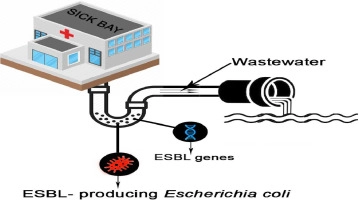Diversity of Extended Spectrum Beta-lactamase (ESBL) genes in Escherichia coli isolated from wastewater generated by a Sick Bay located in a University Health Care Facility

Background
Antibiotic resistance is an ill which has ravaged so many countries of the world, the worst hit being African countries. This study investigated the occurrence of extended spectrum beta-lactamase producing E. coli and their genes in wastewater generated by the sick bay of a University Health Centre Facility.
Methods
Wastewater from three channels in the sick bay were collected over a period of four months for the isolation of E. coli on CHROMAgar E. coli amended with 6 μg/mL of cefotaxime. Molecular characterization of the isolates was done by detecting the presence of uidA gene. Screening for ESBL production was done using Double Disk Synergy Method, and antibiotic susceptibility testing was done using the disc diffusion method. Detection of ESBL genes was done using quantitative PCR.
Results
Twenty-four ESBL positive E. coli possessing the uidA gene were obtained from a pool of thirty-eight E. coli obtained There was 100% resistance to sulfonamide, ertapenem, cefpodoxime and cefotaxime by the isolates, while the resistance to tetracycline was 87.5%, ciprofloxacin (20.8%), ceftazidime (75.0%) and amoxicillin-clavulanate (58.3%). The twenty-four isolates possessed blaCTX-M-1 and blaCTX-M-9, with fourteen possessing blaCTX-M-2, blaCTX-M-8 and blaCTX-M-25. Nineteen isolates harboured blaTEM, while blaCMY-1 was detected in five isolates. One isolate possessed ampC gene. blaKPC, blaNDM-1 and blaSHV were not detected in any isolate.
Conclusion
There is a need for adequate treatment of wastewater from hospital/clinical settings to prevent a public health breakdown as a result of the discharge of untreated wastewater laden with antibiotic resistant bacteria and their genes into the environment.
Publisher URL: https://www.sciencedirect.com/science/article/pii/S2452014420301527
DOI: 10.1016/j.genrep.2020.100738
Keeping up-to-date with research can feel impossible, with papers being published faster than you'll ever be able to read them. That's where Researcher comes in: we're simplifying discovery and making important discussions happen. With over 19,000 sources, including peer-reviewed journals, preprints, blogs, universities, podcasts and Live events across 10 research areas, you'll never miss what's important to you. It's like social media, but better. Oh, and we should mention - it's free.
Researcher displays publicly available abstracts and doesn’t host any full article content. If the content is open access, we will direct clicks from the abstracts to the publisher website and display the PDF copy on our platform. Clicks to view the full text will be directed to the publisher website, where only users with subscriptions or access through their institution are able to view the full article.


